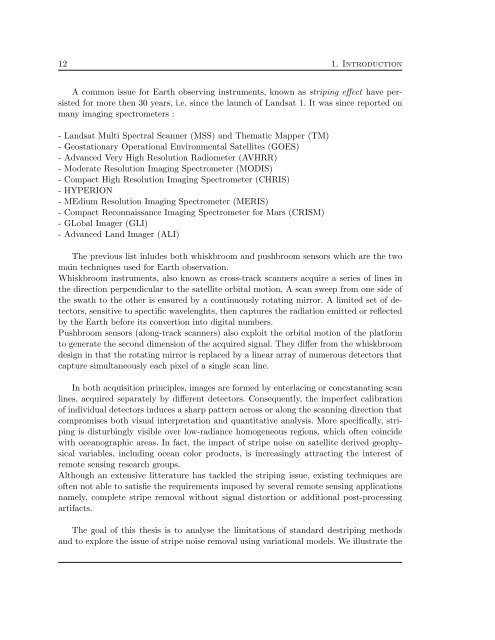Th`ese Marouan BOUALI - Sites personnels de TELECOM ParisTech
Th`ese Marouan BOUALI - Sites personnels de TELECOM ParisTech
Th`ese Marouan BOUALI - Sites personnels de TELECOM ParisTech
You also want an ePaper? Increase the reach of your titles
YUMPU automatically turns print PDFs into web optimized ePapers that Google loves.
12 1. Introduction<br />
A common issue for Earth observing instruments, known as striping effect have persisted<br />
for more then 30 years, i.e, since the launch of Landsat 1. It was since reported on<br />
many imaging spectrometers :<br />
- Landsat Multi Spectral Scanner (MSS) and Thematic Mapper (TM)<br />
- Geostationary Operational Environmental Satellites (GOES)<br />
- Advanced Very High Resolution Radiometer (AVHRR)<br />
- Mo<strong>de</strong>rate Resolution Imaging Spectrometer (MODIS)<br />
- Compact High Resolution Imaging Spectrometer (CHRIS)<br />
- HYPERION<br />
- MEdium Resolution Imaging Spectrometer (MERIS)<br />
- Compact Reconnaissance Imaging Spectrometer for Mars (CRISM)<br />
- GLobal Imager (GLI)<br />
- Advanced Land Imager (ALI)<br />
The previous list inlu<strong>de</strong>s both whiskbroom and pushbroom sensors which are the two<br />
main techniques used for Earth observation.<br />
Whiskbroom instruments, also known as cross-track scanners acquire a series of lines in<br />
the direction perpendicular to the satellite orbital motion. A scan sweep from one si<strong>de</strong> of<br />
the swath to the other is ensured by a continuously rotating mirror. A limited set of <strong>de</strong>tectors,<br />
sensitive to spectific wavelenghts, then captures the radiation emitted or reflected<br />
by the Earth before its convertion into digital numbers.<br />
Pushbroom sensors (along-track scanners) also exploit the orbital motion of the platform<br />
to generate the second dimension of the acquired signal. They differ from the whiskbroom<br />
<strong>de</strong>sign in that the rotating mirror is replaced by a linear array of numerous <strong>de</strong>tectors that<br />
capture simultaneously each pixel of a single scan line.<br />
In both acquisition principles, images are formed by enterlacing or concatanating scan<br />
lines, acquired separately by different <strong>de</strong>tectors. Consequently, the imperfect calibration<br />
of individual <strong>de</strong>tectors induces a sharp pattern across or along the scanning direction that<br />
compromises both visual interpretation and quantitative analysis. More specifically, striping<br />
is disturbingly visible over low-radiance homogeneous regions, which often coinci<strong>de</strong><br />
with oceanographic areas. In fact, the impact of stripe noise on satellite <strong>de</strong>rived geophysical<br />
variables, including ocean color products, is increasingly attracting the interest of<br />
remote sensing research groups.<br />
Although an extensive litterature has tackled the striping issue, existing techniques are<br />
often not able to satisfie the requirements imposed by several remote sensing applications<br />
namely, complete stripe removal without signal distortion or additional post-processing<br />
artifacts.<br />
The goal of this thesis is to analyse the limitations of standard <strong>de</strong>striping methods<br />
and to explore the issue of stripe noise removal using variational mo<strong>de</strong>ls. We illustrate the















